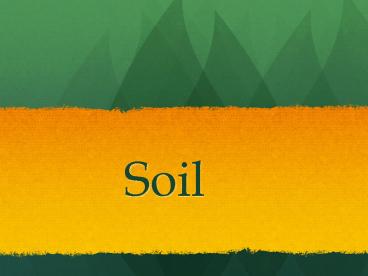Trivedi Science - Improve Soil Quality for Healthy Plant/Crop Growth - PowerPoint PPT Presentation
Title:
Trivedi Science - Improve Soil Quality for Healthy Plant/Crop Growth
Description:
Soil provides the food, water air for your plants and crops to grow better! Learn, how you can improve the quality of soil with Trivedi Science. – PowerPoint PPT presentation
Number of Views:565
Title: Trivedi Science - Improve Soil Quality for Healthy Plant/Crop Growth
1
Soil
2
- Soil is the mixture of minerals, organic matter,
gases, liquids, and the myriad of organisms. It
is a medium for plant growth it is a means of
water storage, supply and purification it is a
modifier of the atmosphere. Soil is considered to
be the "skin of the earth" with interfaces
between the lithosphere, hydrosphere, atmosphere,
and biosphere.
3
(No Transcript)
4
Types of Soil
- Laterite Soil
- Desert Soil
- Mountain Soil
- Saline and Alkaline Soil
- Peaty and Marshy Soil
- Cohesive Soil
- Residual Soil
- Alluvial Soil
- Marine Soil
- Aeolian Soil
- Glacial Soil
5
Soil Testing
- In agriculture, a soil test is the analysis of a
soil sample to determine nutrient and
contaminated content, composition, and other
characteristics such as the acidity or pH level.
A soil test can determine fertility, or the
expected growth potential of the soil, which
indicates nutrient deficiencies, potential
toxicities from excessive fertility and
inhibitions from the presence of non-essential
trace minerals.Laboratory tests often check for
plant nutrients in three categories Major
nutrients nitrogen (N), phosphorus (P), and
potassium (K) Secondary nutrients sulfur,
calcium, magnesium Minor nutrients iron,
manganese, copper, zinc, boron, molybdenum,
chlorine
6
Soil Testing parameters
- The Squeeze Test
- The Percolation Test
- The Worm Test
- Ph. Test
7
Soil Erosion
- Soil erosion is the erosion of soil's upper and
important layer through air and water. The
effects of soil erosion go beyond the loss of
fertile land. It has led to increased pollution
and sedimentation in streams and rivers, clogging
these waterways and causing declines in fish and
other species.
8
(No Transcript)
9
Reasons for Soil Erosion
- Overgrazing
- Heavy Water Flow
- Deforestation
10
Importance of Plants for Soil!
- Plants provide protective cover on the land and
prevent soil erosion for the following reasons. - Plants slow down water as it flows over the land
(runoff) and this allows much of the rain to soak
into the ground. - Plant roots hold the soil in position and prevent
it from being washed away. - Plants break the impact of a raindrop before it
hits the soil, thus reducing its ability to
erode. - Plants in wetlands and on the banks of rivers are
of particular importance as they slow down the
flow of the water and their roots bind the soil,
thus preventing erosion.
11
How to Control SOIL EROSION?
- The use of contour sloughing and windbreaks.
- Leaving unplugged grass strips between ploughed
land. - Making sure that there are always plants growing
on the soil, and that the soil is rich in humus
(decaying plant and animal remains). - Avoiding overgrazing and the over-use of crop
lands. - Allowing indigenous plants to grow along the
river banks instead of sloughing and planting
crops right up to the water's edge. - Encouraging biological diversity by planting
several different types of plants together. - Conservation of wetlands.
12
- For more information, please feel free to contact
www.trivediscience.com































